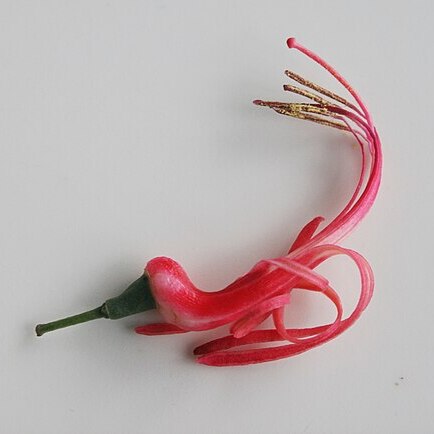Shrubs of moderate to large size, often 1 m or higher. Leaves oblong-linear to elliptic (highly variable in size), (25-)40-60(-85) x 7-20 mm, basinerved, the 3-5 veins sometimes faint. Inflorescence: umbels mostly 2-4(-6)-flowered, borne singly or in pairs, axillary, often on swollen nodes of older branches; pedicels 8-11 mm long. Corolla pink to reddish orange, usually darker toward base, colours often uneven, mottled, or variegated. Filaments and style pinkish apically. Style with single bend toward base. Berries red, smooth. Flowering at least April through August and probably longer.
Petals separate, 4–5 cm long, pink to reddish-orange, usually darker towards base, but sometimes banded or mottled; basal part slightly S-shaped, 9–12 mm long, with 4–5 paired folds inside; distal part recurving, twisted, linear-oblanceolate to linear-spathulate above.
Leaves light green to glaucous; petiole (0)1–6 mm long; lamina 2–12 × 0.4–5.5 cm, variably narrowly oblong to lanceolate, oblanceolate, elliptic-oblong or almost ovate, sometimes slightly curved, cuneate to rounded or exceptionally somewhat sagittate, 3–7-nerved.
A shrub that grows attached to other plants. It grows 2.5 m high. The leaves are narrowly oval but vary in shape. They are 4-6 cm long. They are blue-green. The flowers are in flat topped groups of 2-6 flowers. They are pink to red. The fruit are red berries.
Shrub, up to 1 m high, parasitic on species of Acacia. Leaves basally rounded to cuneate, subpetiolate to petiolate, oblong-linear to elliptic. Style curved or with a single basal bend. Berries red, smooth. Flowers pinkish red.
Umbels 1–4 in the axils or at the nodes below, 3–6-flowered; peduncle (1)3–6 mm long; pedicels 8–12 mm long.
Stamens pinkish; anthers 9–15 mm long.
Berry red, 12–15 × 7–8 mm, urceolate.
Receptacle (5)6–8 mm long, obconic.
Calyx 0.5–1 mm long, rim-like.

